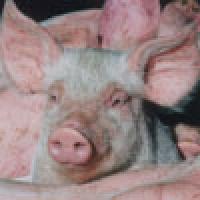
Vaccination works
Infectious diseases are on everyone's mind at the moment. Bird flu has finally arrived in the UK and stringent measures to control the spread of the disease are essential. But what are the best measures? Culling all animals that are infected or at risk? This means death for thousands of healthy animals at a huge cost to farmers and the state that compensates them. Then there is vaccination, but often vaccines are much less than 100% effective, there is only a limited supply of them, and vaccinating all animals may be logistically impossible. If there is not enough vaccine for all animals on a given day, then which animals should be chosen for vaccination?

Vaccinate me!
A surprisingly simple answer to this question was recently found by a team of British and US researchers, who used a mathematical model to predict how infectious diseases spread. Using data from the 2001 foot-and-mouth epidemic in the UK, they investigated strategies that involve responsive vaccination where animals close to infected farms are vaccinated in the hope that they will remain healthy. Their model allows for realistic scenarios where it is logistically and economically unfeasible to vaccinate all the animals that are at risk. The results of their study were recently published in the journal Nature.
According to the new method, authorities should on any given day list all the farms in order of their distance to the nearest infected farms, starting with the shortest distance. Then they should vaccinate farms in that order, using the vaccine to full capacity until it runs out. The researchers' model predicts that this prioritisation works better than any other they investigated. The good thing is that the method is very easy to implement and doesn't require any sophisticated calculations that identify which animals should be classed as "at-risk". Moreover, no change of vaccination policy is necessary even if logistical constraints change, for example if the amount of available vaccine decreases.
To model the spread of the disease the researchers used a mathematical formula that expresses the probability that a given farm becomes infected. Built into this formula there are various parameters that determine this probability, for example the proximity of the farm to infected farms and parameters encoding epidemiological information about how the disease is transmitted. Using data from the 2001 foot-and-mouth epidemic, the researchers calculated what values the epidemiological parameters realistically take. They then used maths to mimic how the disease spreads and what effect control measures like culling and vaccination have on the spread.
Their model predicted that vaccination in conjunction with some culling does work and that less culling is needed when vaccination is used. The responsive vaccination method described above proved to be very effective and the model also highlighted the fact that a speedy response is extremely important. "The key is to vaccinate and to vaccinate fast," says Steve Brooks from the Department of Pure Mathematics and Mathematical Statistics at Cambridge and one of the authors of the article.
Although the study focused on foot-and-mouth disease, its results can be applied equally well to other infectious diseases like bird flu. If the authorities learn from the study, it may help prevent the looming human pandemic. At the very least, it may in future spare us from the horrible images of thousands of burning animal carcasses that flickered across our TV screens during the 2001 foot-and-mouth epidemic.
Further reading
- Read the original article Optimal reactive vaccination strategies for a foot-and-mouth outbreak in the UK.
- Plus articles The mathematics of diseases and Beating bird flu with bills tell you more about maths how maths can beat epidemics.